Evaluation of Direct Sunlight Availability Using a 360° Camera
Abstract
1. Introduction
2. Materials and Methods
3. Results
4. Discussion
- North (orientation = 0°): No sunlight over the cold half of the year, a small amount of direct sunlight over the warm half of the year, peaking at approximately 7 h at the summer solstice, in two short periods, one at sunrise and the other at sunset (Figure 6).
- East (orientation = 90°): The daily duration of direct sunlight varies from under 5 h at the winter solstice to over 7 h at the summer solstice. The duration profile is the same as the west orientation, but direct sunlight is present in the morning rather than in the afternoon.
- South (orientation = 180°): The orientation with the longest direct sunlight exposure on any day of the year. The peaks occur at the spring and fall equinoxes with about 12 h per day. A local minimum occurs on the winter solstice with just over 9 h and an absolute minimum of under 8 h occurs at the summer solstice.
- West (orientation = 270°): The daily duration of direct sunlight varies from under 5 h at the winter solstice to over 7 h at the summer solstice. The duration profile is the same as the west orientation, but direct sunlight is present in the afternoon rather than in the morning.
5. Conclusions
Author Contributions
Funding
Institutional Review Board Statement
Informed Consent Statement
Data Availability Statement
Conflicts of Interest
References
- Hachem, C.; Athienitis, A.; Fazio, P. Parametric investigation of geometric form effects on solar potential of housing units. J. Sol. Energy 2011, 85, 1864–1877. [Google Scholar] [CrossRef]
- Hachem, C.; Athienitis, A.; Fazio, P. Evaluation of energy supply and demand in solar neighborhood. Energy Build. 2012, 49, 335–347. [Google Scholar] [CrossRef]
- Hachem, C.; Fazio, P.; Athienitis, A. Solar optimized residential neighborhoods: Evaluation and design methodology. J. Sol. Energy 2013, 95, 42–64. [Google Scholar] [CrossRef]
- Knowles, R.L. The solar envelope: Its meaning for energy and buildings. Energy Build. 2003, 35, 15–25. [Google Scholar] [CrossRef]
- Compagnon, R. Solar and daylight availability in the urban fabric. Energy Build. 2004, 36, 321–328. [Google Scholar] [CrossRef]
- Cheng, V.; Steemers, K.; Montavon, M.; Compagnon, R. Urban form, density and solar potential. In Proceedings of the 23th Conference on PLEA, Geneva, Switzerland, 6–8 September 2006. [Google Scholar]
- Ghosh, S.; Vale, R. The potential for solar energy use in a New Zealand residential neighborhood: A case study considering the effect on CO2 emissions and the possible benefits of changing roof form. Australas. J. Environ. Manag. 2006, 13, 216–225. [Google Scholar] [CrossRef]
- Ratti, C.; Baker, N.; Steemers, K. Energy consumption and urban texture. Energy Build. 2005, 37, 762–776. [Google Scholar] [CrossRef]
- Bellia, L.; Fragliasso, F.; Pedace, A. Evaluation of Daylight Availability for Energy Savings. J. Daylight. 2015, 2, 12–20. [Google Scholar] [CrossRef]
- Christensen, C.; Horowitz, S. Orienting the neighborhood: A subdivision energy analysis tool. In Proceedings of the ACEEE Summer Study on Energy Efficiency in Buildings, Pacific Grove, CA, USA, 17–22 August 2008. [Google Scholar]
- Colona, E.C. Potential reduction in energy consumption in consolidated built environments. An analysis based on climate, urban planning and users. VITRUVIO Int. J. Archit. Technol. Sustain. 2018, 3, 47–71. [Google Scholar] [CrossRef]
- Achsani, R.A.; Paramitasari, A.U.; Sugangga, M.; Wonorahardjo, S.; Triyadi, S. Optimization of daylighting outdoor availability in urban kampung. In IOP Conference Series: Earth and Environmental Science, Proceedings of the 5th HABITechno International Conference, Bandung, Indonesia, 11 November 2021; IOP Publishing: Bristol, UK, 2021. [Google Scholar] [CrossRef]
- Verso, V.R.M.L.; Antonutto, G.; Torres, S. Sunlight-Daylight Signature: A Novel Concept to Assess Sunlight and Daylight Availability at Urban Scale. J. Daylight. 2023, 10, 136–152. [Google Scholar] [CrossRef]
- Bellia, L.; Acosta, I.; Campano, M.A.; Fragliasso, F. Impact of daylight saving time on lighting energy consumption and on the biological clock for occupants in office buildings. Sol. Energy 2020, 211, 1347–1364. [Google Scholar] [CrossRef]
- Tabadkani, A.; Roetzel, A.; Li, H.X.; Tsangrassoulis, A. Daylight in Buildings and Visual Comfort Evaluation: The Advantages and Limitations. J. Daylight. 2021, 8, 181–203. [Google Scholar] [CrossRef]
- Acosta, I.; Campano, M.A.; Bellia, L.; Fragliasso, F.; Diglio, F.; Bustamante, P. Impact of Daylighting on Visual Comfort and on the Biological Clock for Teleworkers in Residential Buildings. Buildings 2023, 13, 2562. [Google Scholar] [CrossRef]
- Pol, O.A.; Robinson, D. Impact of urban morphology on building energy needs: A review on knowledge gained from modeling and monitoring activities. In Proceedings of the CISBAT, Lausanne, Switzerland, 14–16 September 2011. [Google Scholar]
- Leung, K.S.; Steemers, K. Exploring solar responsive morphology for high-density housing in the tropics. In Proceedings of the CISBAT, Lausanne, Switzerland, 2–3 September 2009. [Google Scholar]
- Kämpf, J.H.; Robinson, D. Optimisation of building form for solar energy utilization using constrained evolutionary algorithms. Energy Build. 2010, 42, 807–814. [Google Scholar] [CrossRef]
- Morello, E.; Gori, V.; Balocco, C.; Ratti, C. Sustainable urban block design through passive architecture, a tool that uses urban geometry optimization to compute energy savings. In Proceedings of the 26th Conference on Passive and Low Energy Architecture, Quebec City, QC, Canada, 22–24 June 2009. [Google Scholar]
- Strømann-Andersen, J.; Sattrup, P.A. The urban canyon and building energy use: Urban density versus daylight and passive solar gains. Energy Build. 2011, 43, 2011–2020. [Google Scholar] [CrossRef]
- Capeluto, I.G. The influence of the urban environment on the availability of daylighting in office buildings in Israel. Build. Environ. 2003, 38, 745–752. [Google Scholar] [CrossRef]
- Jabareen, Y.R. Sustainable urban forms: Their typologies, models, and concepts. J. Plan. Educ. Res. 2006, 26, 38–52. [Google Scholar] [CrossRef]
- Ali-Toudert, F. Energy efficiency of urban buildings: Significance of urban geometry, building construction and climate. In Proceedings of the CISBAT, Lausanne, Switzerland, 2–3 September 2009. [Google Scholar]
- Nault, E.; Moonen, P.; Rey, E.; Andersen, M. Predictive Models for Assessing the Passive Solar and Daylight Potential of Neighborhood Designs: A comparative proof-of-concept study. Build. Environ. 2017, 116, 1–16. [Google Scholar] [CrossRef]
- Lechner, N. Heating, Cooling and Lighting, 4th ed.; John Wiley & Sons, Inc.: Hoboken, NJ, USA, 2015; pp. 400–450. [Google Scholar]
- Duluk, S.; Nelson, H.; Kwok, A. Comparison of solar evaluation tools: From learning to practice. In Proceedings of the 42nd Annual National Solar Conference, Baltimore, MD, USA, 16–20 April 2013. [Google Scholar]
- Alhmoud, L. Why Does the PV Solar Power Plant Operate Ineffectively? Energies 2023, 16, 4074. [Google Scholar] [CrossRef]
- Shadow Analysis. Tools and Software. Available online: https://www.linkedin.com/pulse/shadow-analysis-tools-software-eduardo-rodriguez-e-i-t- (accessed on 21 September 2024).
- Computing Planetary Positions—A Tutorial with Worked Examples. Available online: http://stjarnhimlen.se/comp/tutorial.html#5 (accessed on 29 May 2023).
- Darin Koblick. Vectorized Solar Azimuth and Elevation Estimation, MATLAB Central File Exchange. Available online: https://www.mathworks.com/matlabcentral/fileexchange/23051-vectorized-solar-azimuth-and-elevation-estimation (accessed on 29 May 2023).









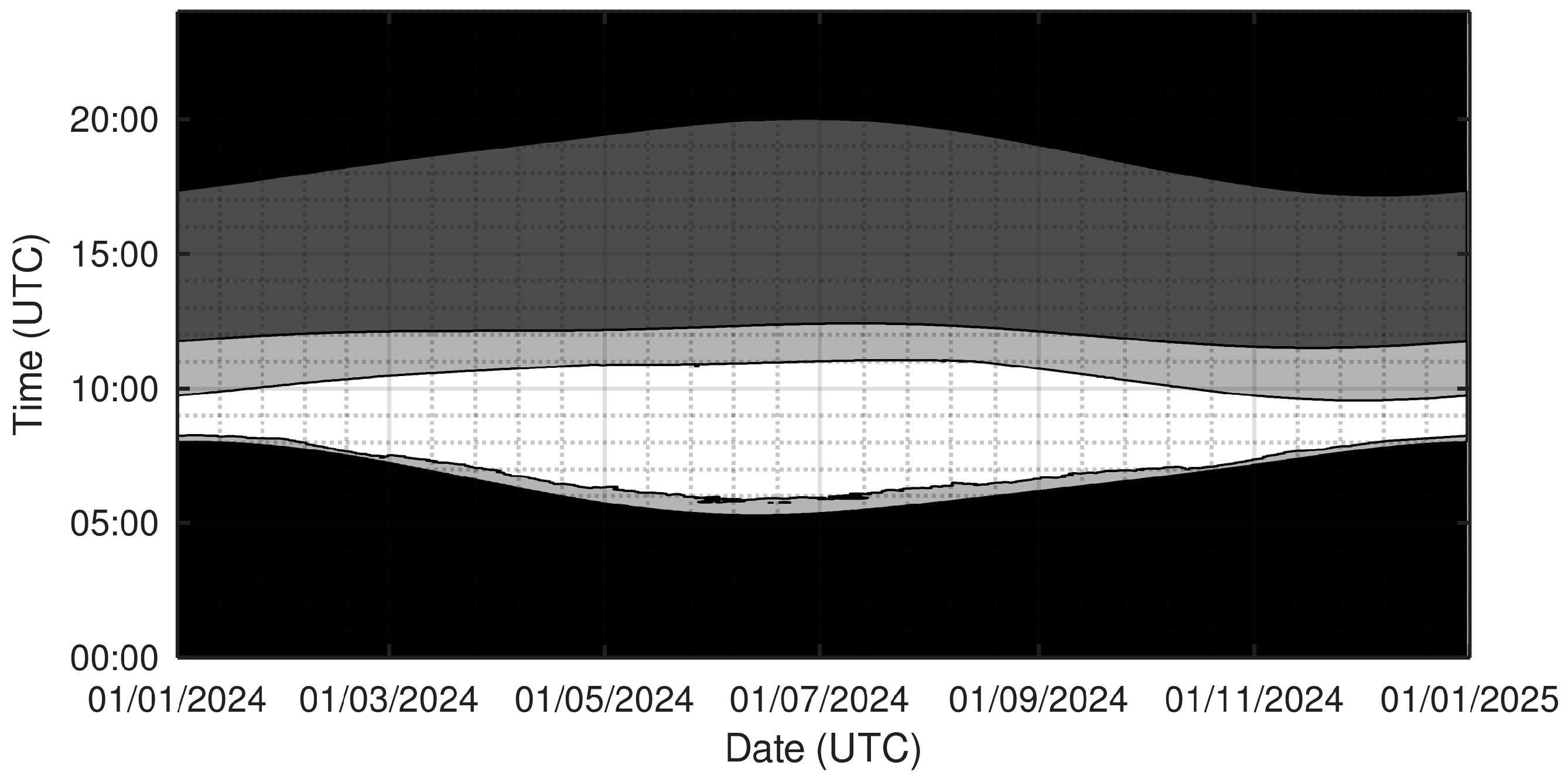

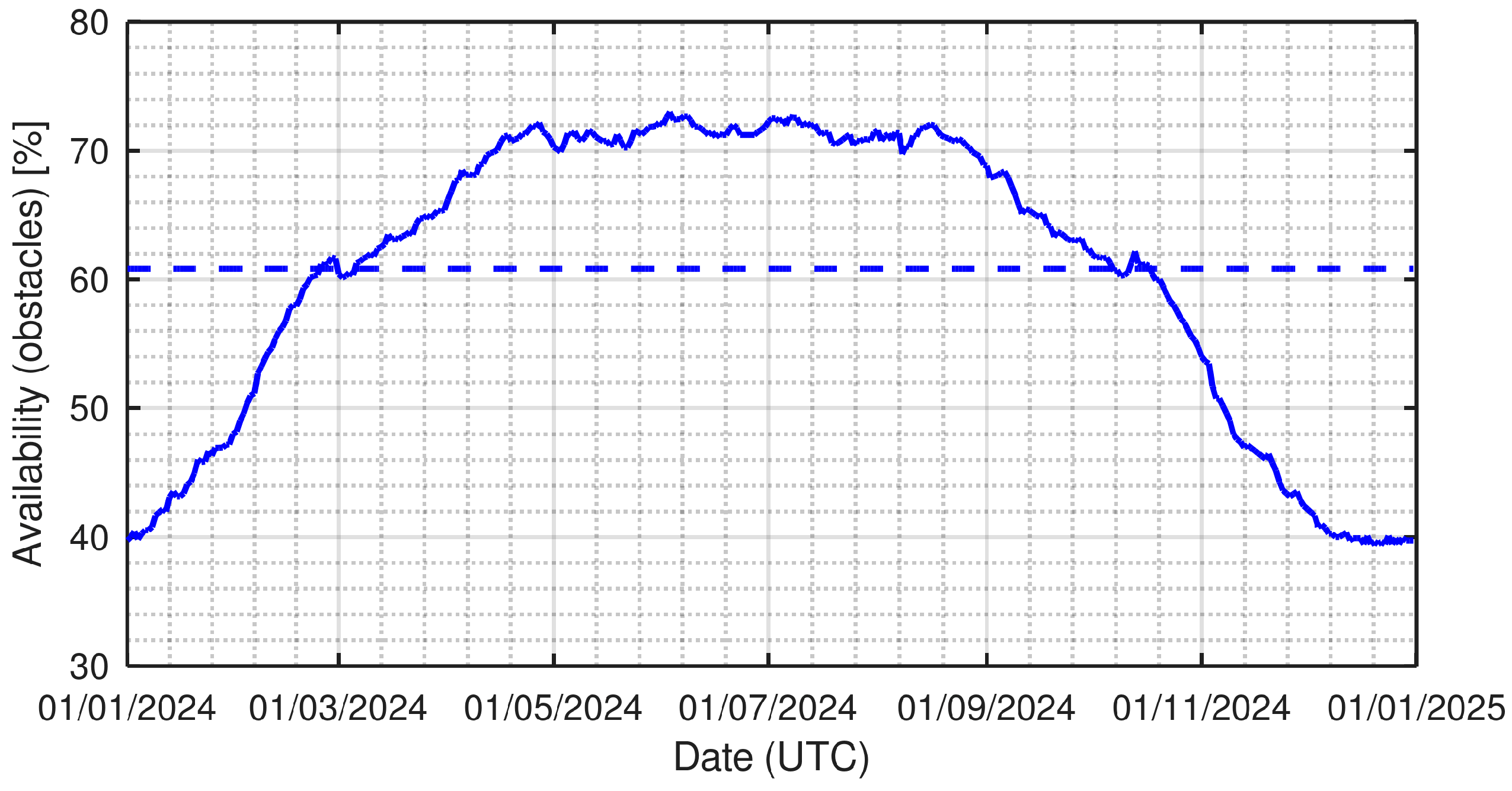


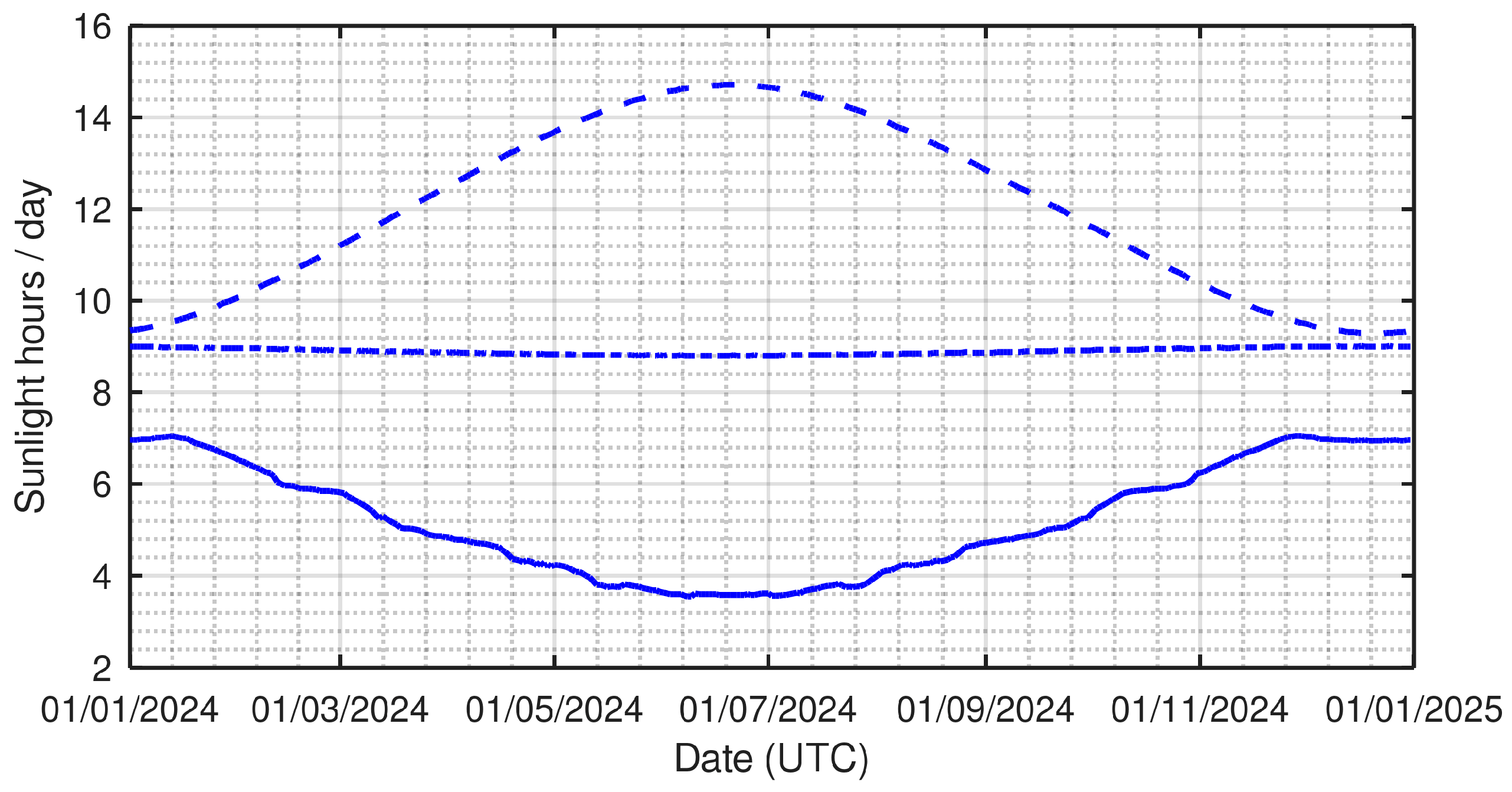
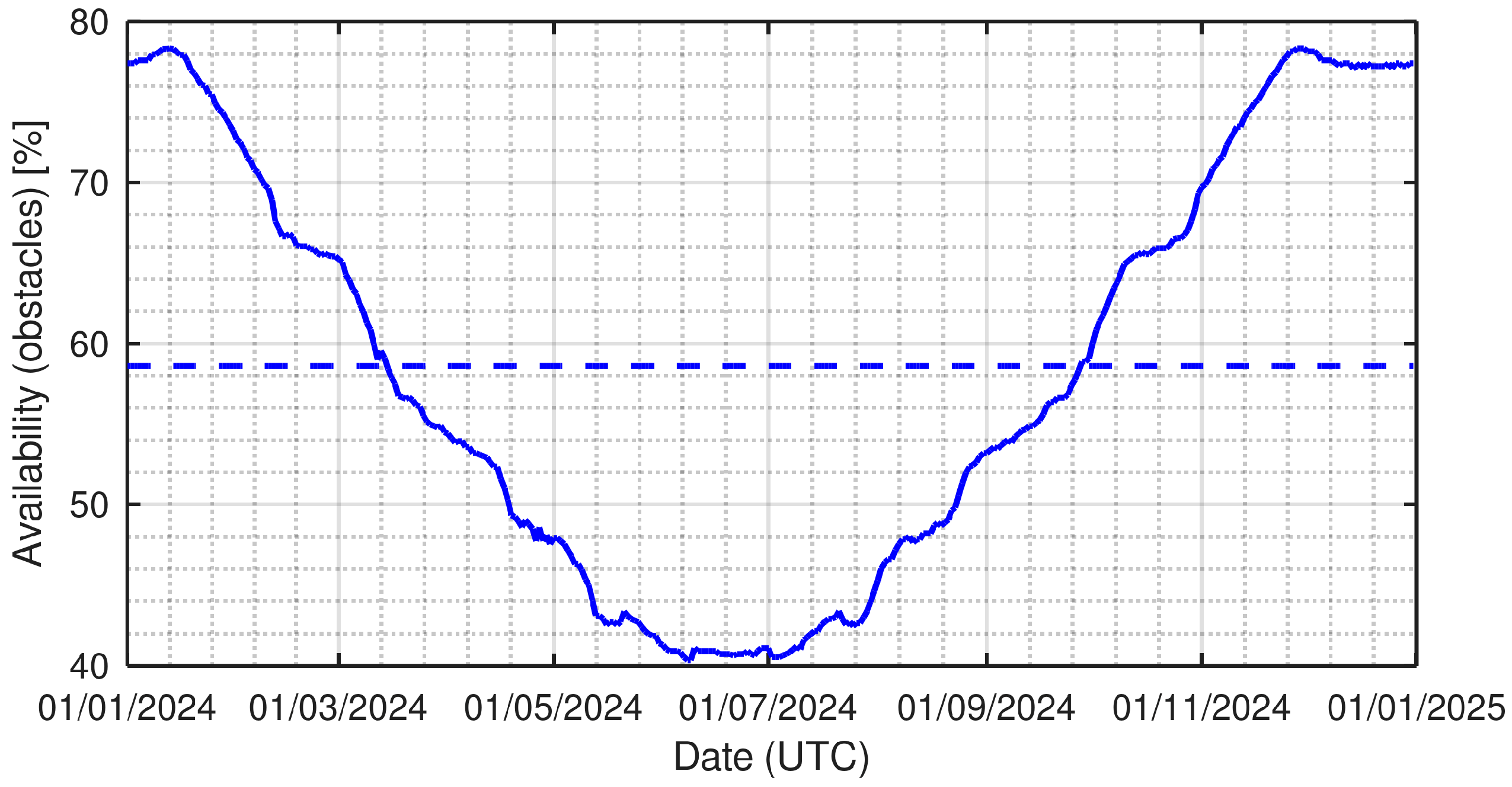


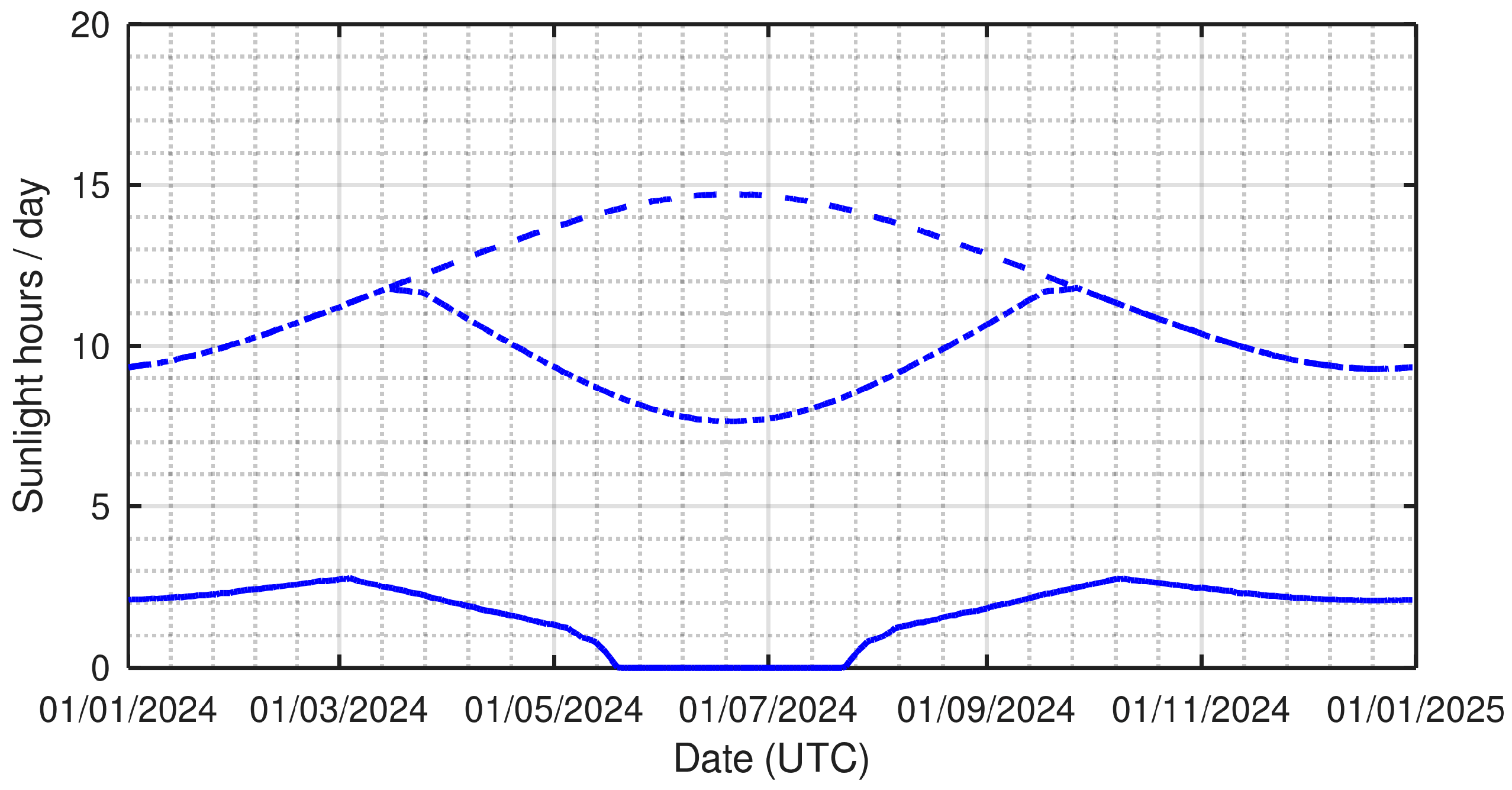









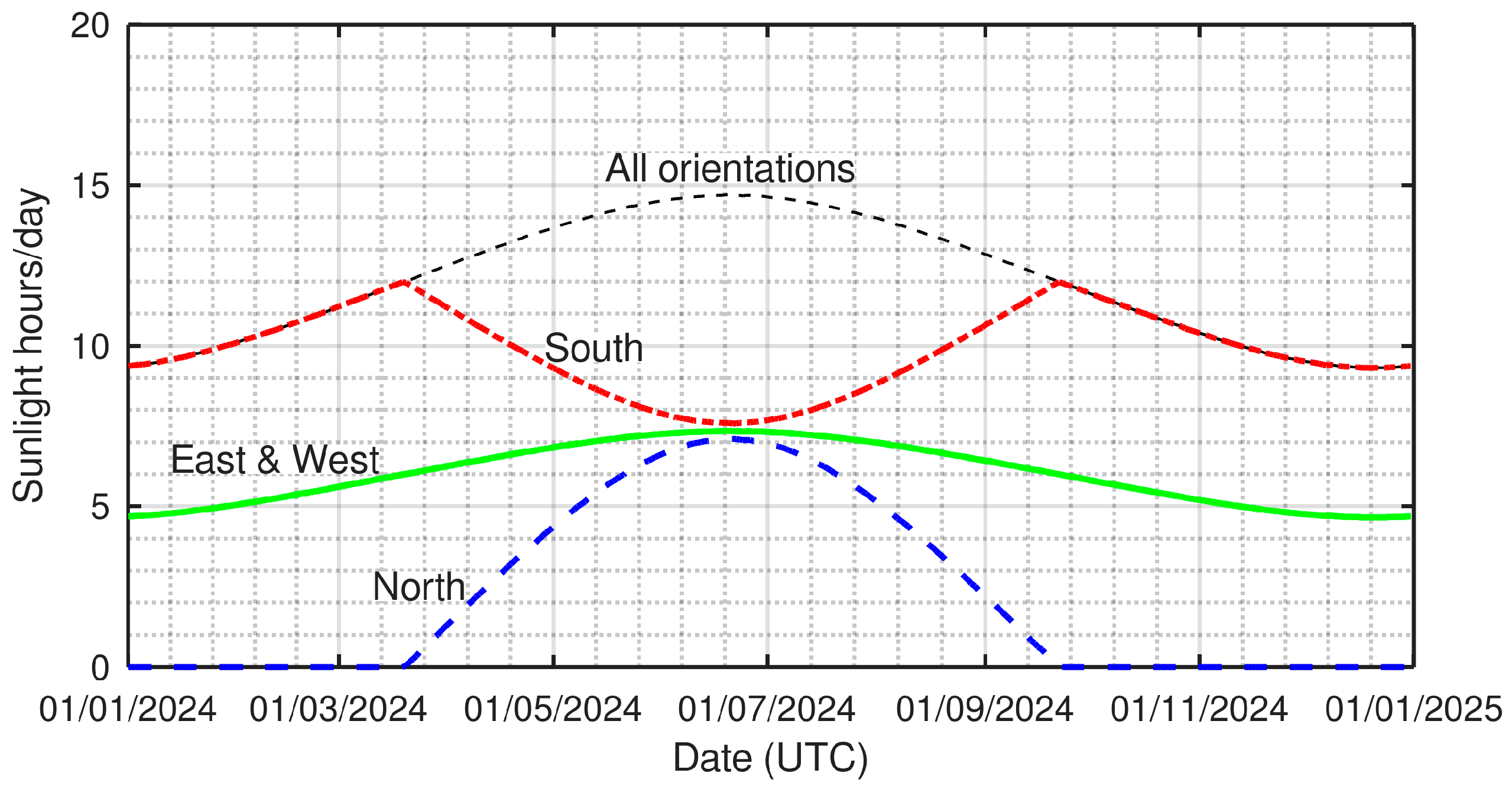
Disclaimer/Publisher’s Note: The statements, opinions and data contained in all publications are solely those of the individual author(s) and contributor(s) and not of MDPI and/or the editor(s). MDPI and/or the editor(s) disclaim responsibility for any injury to people or property resulting from any ideas, methods, instructions or products referred to in the content. |
© 2024 by the authors. Licensee MDPI, Basel, Switzerland. This article is an open access article distributed under the terms and conditions of the Creative Commons Attribution (CC BY) license (https://creativecommons.org/licenses/by/4.0/).
Share and Cite
Chambel Lopes, D.; Nogueira, I. Evaluation of Direct Sunlight Availability Using a 360° Camera. Solar 2024, 4, 555-571. https://doi.org/10.3390/solar4040026
Chambel Lopes D, Nogueira I. Evaluation of Direct Sunlight Availability Using a 360° Camera. Solar. 2024; 4(4):555-571. https://doi.org/10.3390/solar4040026
Chicago/Turabian StyleChambel Lopes, Diogo, and Isabel Nogueira. 2024. "Evaluation of Direct Sunlight Availability Using a 360° Camera" Solar 4, no. 4: 555-571. https://doi.org/10.3390/solar4040026
APA StyleChambel Lopes, D., & Nogueira, I. (2024). Evaluation of Direct Sunlight Availability Using a 360° Camera. Solar, 4(4), 555-571. https://doi.org/10.3390/solar4040026






